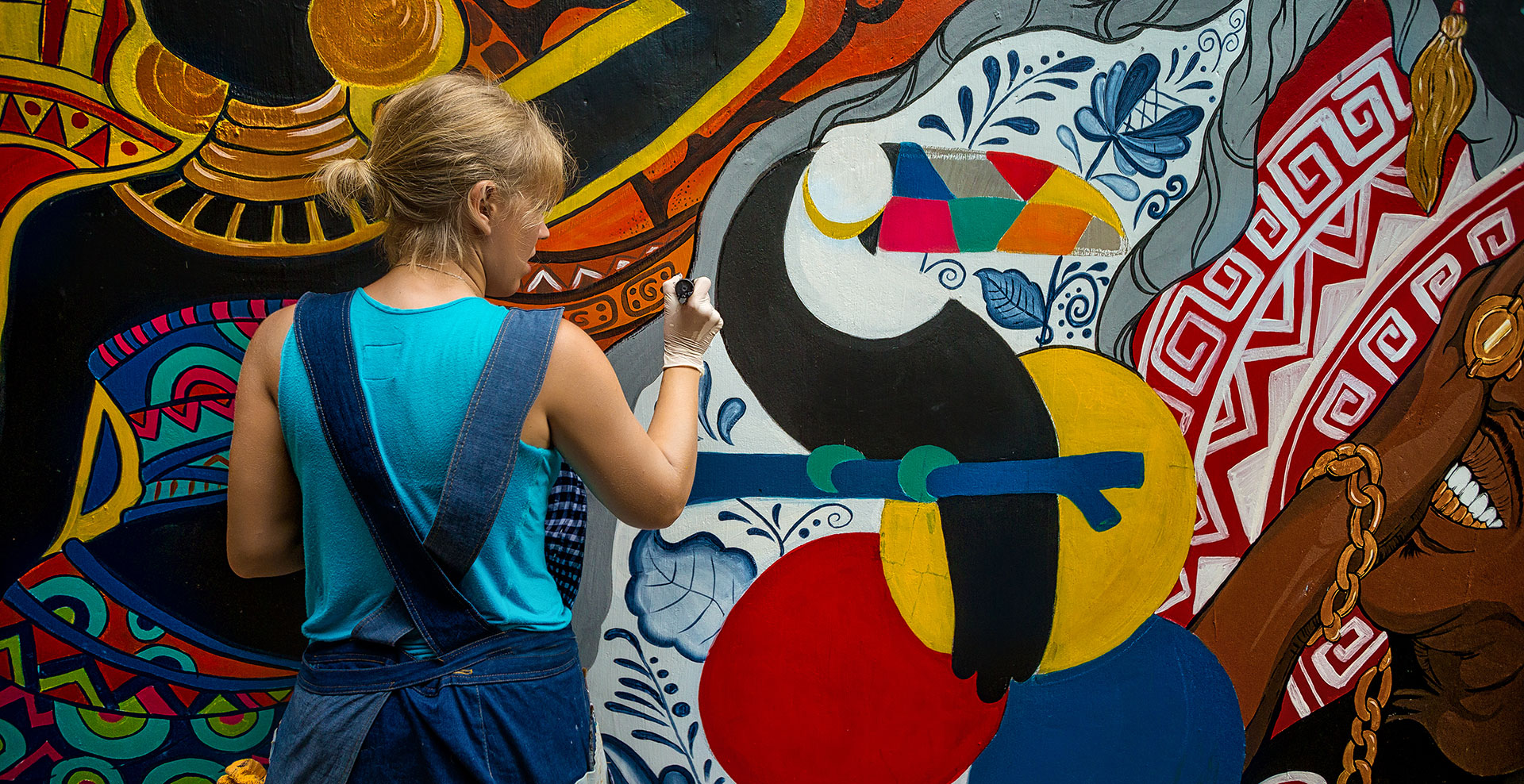
Protection for Street Art on Buildings
Intellectual Property Update
Protection for Street Art on Buildings
Real estate developers generally understand they can remodel or remove the buildings they own. Advertisers generally understand they can use buildings visible from the street as background for photo shoots. But what about rights in murals or sculptures adorning the buildings?
When the pandemic recedes, developers and property owners will be anxious to recoup lost tenants and lost rent. Property improvements to attract new tenants and higher rents could involve installing new or removing old works of visual art. Likewise advertisers launching new marketing campaigns may be attracted to new or old street art to create a desired brand aesthetic. Legal counsel should be included in these decisions to avoid unintended consequences from failing to account for the rights of visual artists.
Since December 1990, the Visual Artist Rights Act (VARA) has provided additional rights to authors of “a work of visual art,” which includes “a painting , drawing , print, or sculpture, existing in a single copy.” 17 USC §101. The author of a work of visual art also has the traditional exclusive rights under copyright law. 17 USC §106.
Part One — Developers and Destruction of Street Art
An architect owns a copyright in the architectural work she creates, but cannot prevent the “alteration or destruction” of the building. 17 USC §120. VARA, however, grants the author of a work of visual art rights of attribution and integrity broader than the rights granted an architect.
The Author’s Right To Prevent Modification Or Destruction Of Certain Works Under VARA. The author of a work of visual art has the right to prevent: (1) “any intentional distortion, mutilation, or modification” of that work (to protect the artist’s reputation); and (2) “any intentional or grossly negligent destruction” of a “work of recognized stature.” 17 USC §106A (a)(3)(emphasis added). For a work created after 1990, these rights endure for the life of the author. Id., §106A (d)(1). These rights can only be lost by a written waiver signed by the author identifying the work and the use of the work. Id., §106A (e)(1). A transfer of ownership of the copy of or the copyright in the work does not constitute the required waiver. Id., §106A (e)(2).
Limitations Under VARA For Works Of Visual Art Incorporated In A Building. For a work “incorporated in or made part of a building,” the rights provided under VARA do not apply if the author gives consent in a signed, written instrument, specifying that removal of the work “may subject the work to destruction, distortion, mutilation, or other modification.” 17 USC §113(d)(1). However, if the work can be removed without causing the destruction, distortion, mutilation, or other modification of the work, then the owner must attempt to notify the author as provided in the statute. Id., §113(d)(2). The author then has 90 days to “remove the work or pay for its removal” and then owns that copy of the work. Id.
Developers must consider the rights granted visual artists under VARA and comply with the statutory notice provisions. In a recent appeal from a 3 week trial, the appellate court found willful destruction of 45 works of street art of recognized stature and awarded the artists VARA damages of $6.75 million ($150,000 per work) against the developer. Castillo v G&M Realty, LP, 950 F3d 155 (2nd Cir. 2020) (whitewashing 5Pointz in Long Island City NY). The property, dilapidated warehouse buildings, had been used with the owner’s permission as an exhibition space for aerosol artists drawing thousands of visitors daily. The developer wanted to (and ultimately did) build luxury apartments. This developer has petitioned to the US Supreme Court seeking to avoid the adverse judgement. Another ongoing VARA case was brought by muralist Kyle Holbrook against the City of Pittsburg and other defendants.
An earlier VARA case involved sculpture destroyed in an urban renewal project. Martin v. City of Indianapolis, 192 F.3d 680 (7th Cir. 1999). The artist was awarded the maximum statutory damages then allowed for non-willful infringement ($20,000). Dissenting in part, Judge Manion noted:
For now, however, those who are purchasers or donees of art had best beware. To avoid being the perpetual curator of a piece of visual art that has lost (or perhaps never had) its luster, the recipient must obtain at the outset a waiver of the artist’s rights under VARA. . . . If not, once destroyed, art of questionable value may acquire a minimum worth of $20,000.00 under VARA.
192 F.3d at 616.
Indeed, the problem could get even worse. First statutory damages have been increased to $30,000 ($150,000 for willful infringement). Second, an unfinished work may be entitled to protection under VARA. Mass. Museum of Contemporary Art Foundation, Inc. v. Buchel, 593 F3d 38, 50-52 (ist Cir. 2010). Third, one judge has noted “there is no basis in the statute to find a general right to destroy works of art that are on property without permission of the owner.” Pollard v. Seymour, 150 F.Supp.2d 393, 396 n.4 (NDNY 2001). Can an artist trespass to create (or perhaps merely begin to create) a “work of recognized stature” and thereby delay development of the property? That scenario seems inequitable and therefore unlikely, but it emphasizes that the VARA right of integrity cannot be ignored.
Part Two — Advertisers and Pictorial Representations of Street Art.
Does VARA Apply? The right of integrity under VARA prevents an “intentional distortion, mutilation, or modification” of “that work” — the original, physical work of visual art itself. “The right of integrity allows the [artist] to prevent deforming or mutilating changes to his work ….” Carter v. Helmsley-Spear, Inc., 71 F.3d 77, 81 (2d Cir. 1995) (emphasis added). Therefore, VARA does not apply to an ad campaign if only images of the work (not the original) were altered.
Does Copyright Law Apply? To address an unauthorized copy, whether or not modified or distorted, the visual artist may rely on traditional copyright law. If she owns the copyright in a painting or sculpture, an author can assert infringement of her exclusive right to create a “copy” or a “derivative work” in which the author’s work is “recast, transformed or adapted.” 17 USC §§101, 106(1) and (2). See, e.g., Gaylord v. United States, 595 F.3d 1364 (Fed. Cir. 2010)(modified image of a sculpture used on a postage stamp).
Limitations Under Copyright Law If Works of Visual Art Are Considered Buildings. Copyright claims are subject to a limitation for “architectural works” – “the design of a building as embodied in . . . [the] building.” 17 USC §101. The author of an architectural work cannot prevent the creation, distribution or display of “pictorial representations” of a building “located in or ordinarily visible from a public place.” 17 USC §120. So when can the “work of visual art” be deemed a “building” under copyright law?
Whether a painting or sculpture on or adjacent to a building is within the limited right to create “pictorial representations” of the building has been litigated in several cases. The leading case considered whether a sculptural streetwall and courtyard (Zanja Madre) was part of a larger architectural work. The required streetwall and towers matched the building, were designed to appear to be part of the building and channeled traffic into the adjacent courtyard. As part of the building, pictorial representations of the towers (as the Second Bank of Gotham) were permitted in defendant’s movie, Batman Forever, under 17 USC §120. Leicester v. Warner Brothers, 232 F.3d 1212 (9th Cir. 2000).
Two recent cases reached different determinations concerning whether murals were part of buildings under 17 USC §120. Compare Falkner v General Motors, 393 F.Supp.3d 297 (C.D. Ca 2018)(mural on a parking garage was not “part” of the building and author could pursue a copyright infringement claim for commercial use of a photograph on social media); with Mercedes Benz v. Lewis, 2019 WL 4302769 (E.D. Mich. 2019)(murals on buildings could be design elements and use of photographs on Instagram may be permitted). Neither case has reached a final judgement.
The statute permitting pictorial representations of buildings does not necessarily apply to copyrighted works of art just because they are associated with buildings. This analysis is fact specific. Advertisers need to consider carefully whether the copyright statute concerning buildings, fair use, or some other defense to copyright infringement applies to use of images that include street art.
Developers and advertisers may be exposed to substantial copyright damages for infringement of VARA or traditional copyright law. Legal counsel should be included in these decisions to avoid unintended consequences from failing to account for the rights of visual artists.
Get MORE. Insights
Stay ahead in the legal world - subscribe now to receive the latest insights and news from Fennemore Law Directly in your inbox!

